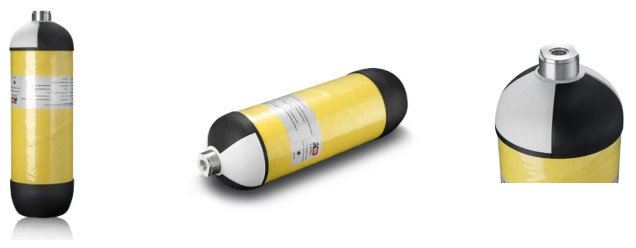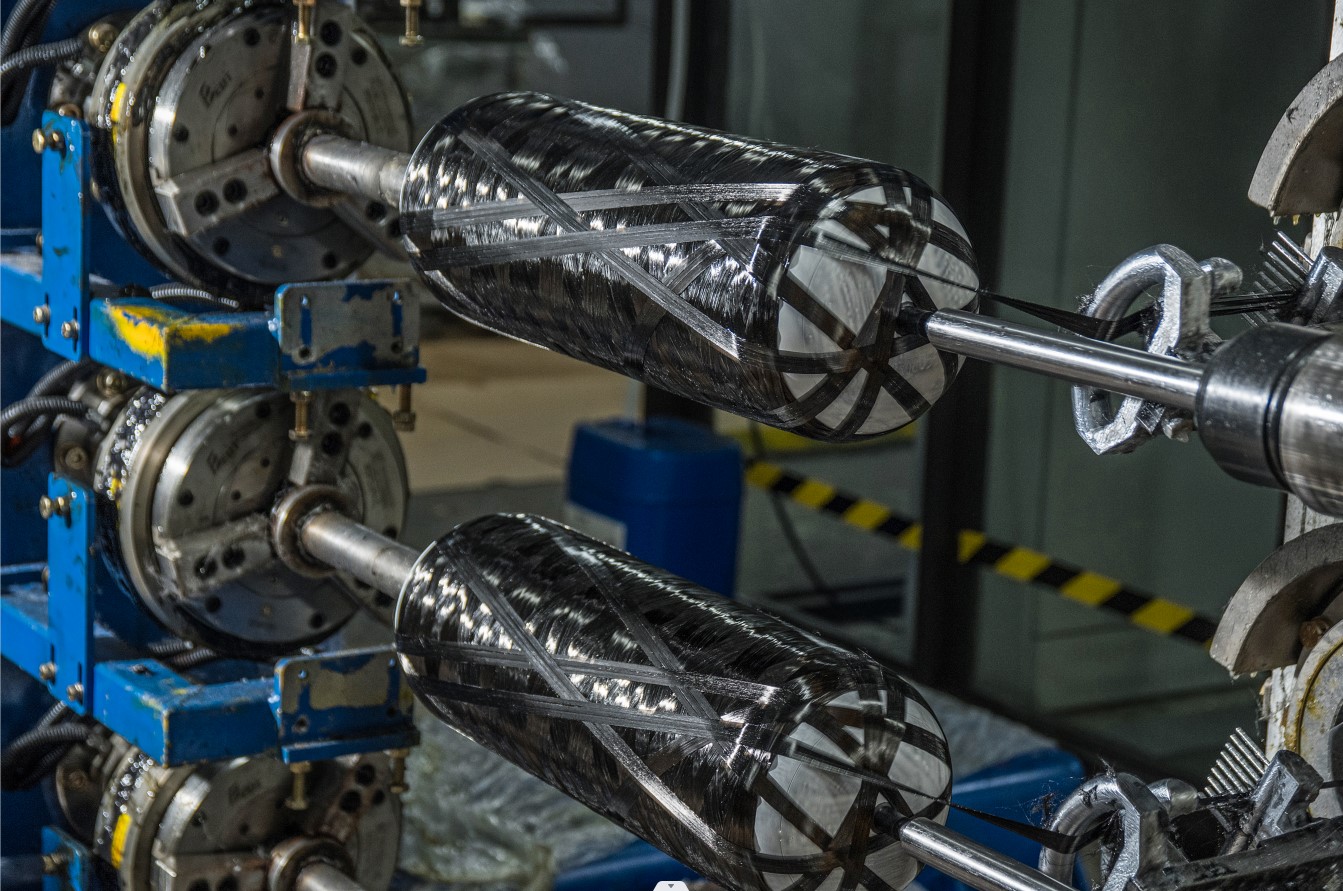Type 4 carbon fiber cylinders represent a leap forward in the development of lightweight, high-pressure storage solutions. Unlike traditional steel or aluminum cylinders, these are built using a plastic liner, typically made of PET (Polyethylene Terephthalate), which is then wrapped in carbon fiber. This construction provides both durability and a significant reduction in weight, making them ideal for industries requiring high-pressure gas storage, such as compressed air for SCBA (Self-Contained Breathing Apparatus), natural gas storage, and other specialized applications.
Structure of Type 4 Cylinders
At the core of a Type 4 cylinder is a PET liner, which serves as the gas-tight layer. This liner is non-metallic, which distinguishes Type 4 from other cylinder types. Over the PET liner, carbon fiber is wrapped in multiple layers to provide structural strength. This wrapping process ensures the cylinder can withstand the high internal pressures required for storing gases like oxygen, air, or natural gas.
The outer coating of the cylinder often includes an enhanced high-polymer protective layer, offering added protection from environmental factors, such as UV rays, chemicals, and moisture. The entire design is aimed at providing superior strength and safety, while still being much lighter than metal alternatives.
Key Features of Type 4 Carbon Fiber Cylinders
- Lightweight Design: One of the main advantages of Type 4 cylinders is their lightweight nature. The use of PET for the liner and carbon fiber for the reinforcement drastically reduces the cylinder’s weight compared to traditional metal tanks. This makes them easier to handle, transport, and install in various systems, particularly in mobile applications.
- Carbon Fiber Wrapping: Carbon fiber is known for its exceptional tensile strength, which allows Type 4 cylinders to store gases at high pressures—typically up to 4500 PSI or more—while maintaining their structural integrity. Carbon fiber is both strong and light, providing the ideal balance for applications where weight is a critical factor.
- High-Polymer Coat: The high-polymer coating adds another layer of protection, enhancing the durability of the cylinder against external environmental factors. This coat serves as a barrier against moisture, chemicals, and UV light, ensuring that the carbon fiber structure remains intact for extended periods, even in harsh conditions.
- Rubber Caps and Multi-Layer Cushioning: To prevent damage from physical impacts, rubber caps are added to both the shoulder and foot of the cylinder. These caps act as buffers, protecting the cylinder from drops or knocks that could compromise its integrity. Additionally, the cylinder includes multi-layer cushioning, which absorbs external impacts, further safeguarding the inner PET liner and carbon fiber structure from damage.
- Flame-Retardant Design: For safety purposes, many Type 4 carbon fiber cylinders are designed with flame-retardant materials throughout the structure. This feature is crucial in environments where the cylinder may be exposed to high temperatures or flames, such as firefighting equipment or industrial settings.
Advantages of Type 4 Carbon Fiber Cylinders
- Weight Reduction: Compared to steel or aluminum cylinders, Type 4 cylinders are significantly lighter, often by as much as 60%. This reduction in weight is especially important in applications like SCBA units for firefighters, where mobility and ease of movement are critical. The lightweight design reduces the strain on users, making it easier to carry the cylinders for extended periods.
- Durability: Carbon fiber offers high tensile strength, allowing these cylinders to handle high pressures without risking rupture or failure. The PET liner ensures that the cylinder remains gas-tight, while the carbon fiber wrapping provides the necessary structural support. Additionally, the protective coatings and rubber caps enhance the overall durability, making Type 4 cylinders more resistant to environmental wear and tear.
- Corrosion Resistance: Unlike steel cylinders, which can corrode over time, Type 4 cylinders are corrosion-resistant due to the use of PET and carbon fiber. This extends the lifespan of the cylinder and makes them suitable for environments where moisture or chemicals are present.
- Improved Safety: The flame-retardant materials and protective layers used in Type 4 cylinders add a level of safety that is not always present in traditional metal cylinders. This makes them ideal for industries where safety is paramount, such as firefighting, mining, and emergency response.
- Longer Lifespan: Type 4 cylinders, due to their non-metallic construction, do not suffer from the same wear and tear as metal cylinders. With proper maintenance and inspections, they can offer a longer service life, making them a cost-effective option in the long term.
Applications of Type 4 Carbon Fiber Cylinders
- SCBA for Firefighters: In firefighting, SCBA systems must be lightweight and durable. The reduced weight of Type 4 cylinders means firefighters can move more freely and with less fatigue, while the high-pressure capacity ensures they have a sufficient air supply for the duration of their mission.
- Natural Gas Storage: Type 4 cylinders are increasingly being used in natural gas storage systems, particularly in vehicles powered by compressed natural gas (CNG). The lightweight design helps improve fuel efficiency, while the high-pressure capacity allows for greater storage in smaller spaces.
- Aerospace and Aviation: The aviation industry benefits from the weight reduction offered by Type 4 carbon fiber cylinders. In an industry where weight savings directly translate to fuel efficiency and cost reductions, these cylinders provide a practical solution for storing compressed air or oxygen.
- Medical Oxygen Cylinders: Type 4 carbon fiber cylinders are also used in medical oxygen systems, where portability and ease of handling are critical. Patients or medical professionals can easily transport these lightweight cylinders without sacrificing the capacity or pressure needed for emergency or long-term oxygen supply.
Conclusion
Type 4 carbon fiber cylinders offer a modern solution to the challenges of high-pressure gas storage, providing a balance of strength, safety, and weight reduction. With their PET liners, carbon fiber reinforcement, and protective features, they are well-suited for demanding applications across industries like firefighting, aviation, and medical gas supply. As technology continues to evolve, the versatility and reliability of Type 4 cylinders make them a preferred choice for those looking for high-performance, long-lasting storage solutions.
Post time: Sep-29-2024


